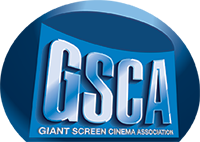The dome marketplace is a significant part of the GS exhibition network. Domes can provide the most compelling experience for some GS projects, and it is therefore critical to create the best possible films for domes.
The dome is the most demanding screen in the world. It is larger from the audience’s perspective than any other movie screen. As a result, when “dome reversioning” is done from non-dome masters, the cropping used to re-compose for the dome makes the image softer. Then it is projected on an even larger screen. As a result, films “re-versioned” for the dome often look soft. It is a much better idea to shoot for the dome and then “re-version” the flat version from the dome version, as the flat screen is far less demanding.
For films intended to play on domes, special consideration must be given to framing and composition, as well as saturation, brightness, and contrast. It is possible to create quality dome versions from flat 2D or 3D originals, however doing so involves considerable expense, time, and effort. Not every film has the budget to create a special dome version. However, if this is not done, certain scenes may appear distorted when projected onto a dome, or in the case of scenes with a large amount of optical parallax, will not exploit the full power of the immersive dome format.
If scenes cannot be shot in dome format, the next best alternative is to be conscious of dome framing and composition while shooting. Many producers have successfully shot films that work on flat screens and domes, with little additional effort or expense. Proper instruction in advance of shooting, along with constant reference to the Imagica Sacred Master, will help ensure a satisfying result.
If a film does not work well within the dome requirements, digital tools and tricks like reframing, frame extensions, mosaic, and tiling can be used to make it more appealing. Cross reflectance on dome screens requires additional choices be made about proper contrast, color saturation (chroma levels), black levels (gamma), etc., to ensure the very best experience.
Refer to the GSCA’s published Digital Immersive Giant Screen Specifications 1.2, available on GSCA’s website.
To be presented properly in a dome, a film should be have the taller 4×3 aspect ratio, otherwise there will be no image on the back third of the dome.
A spotting session is necessary to determine what work will be needed for each shot in the dome version.
 Forward to 39. Dome Color Grade
Forward to 39. Dome Color Grade
 Back to 37. Conform 20-Minute Version
Back to 37. Conform 20-Minute Version
